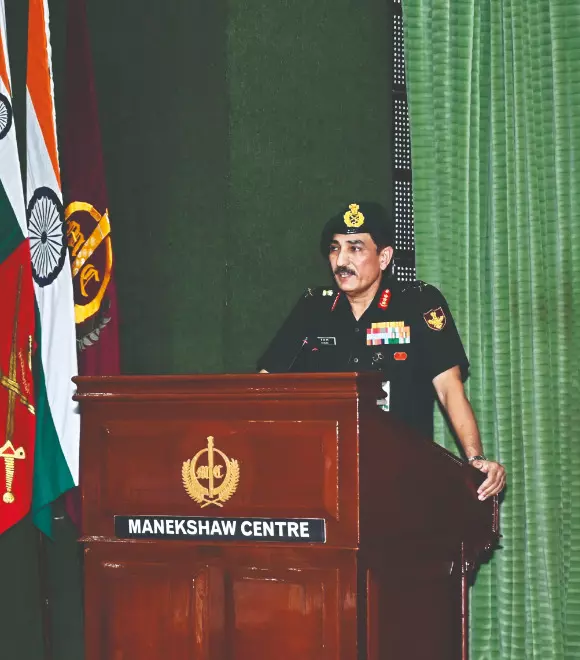India presents ‘Op Sindoor’ as novel template in counter-terror strategy

New Delhi: In a major diplomatic initiative, Lieutenant General DS Rana, Director General of the Defence Intelligence Agency (DIA), addressed Foreign Service Attaches (FSAs) from 70 countries on Tuesday here in the capital, on the successful conduct of ‘Operation Sindoor’.
The military operation, initiated in retaliation to the Pahalgam terror attack in South Kashmir, has been envisioned as a turning point in India-Pakistan relations, heralding a new paradigm of military precision, technological superiority, and strategic restraint.
Lt Gen Rana pointed out India’s unflinching national determination and operational dominance, which were aptly exemplified by multi-domain warfare capabilities. He discussed the purposeful planning behind the operation, adding that target selection was strictly based on established terror linkages. The Indian armed forces’ integrated response, orchestrated across the land, air, cyber, and space domains, successfully neutralised high-value targets without civilian casualties—emphasising India’s adherence to ethical warfare.
‘Operation Sindoor’ was launched after the April 22 attack in Pahalgam, in which Pakistan-sponsored militants attacked civilians based on religion and killed 26 innocent individuals. The mode of the attack indicated a departure from traditional cross-border terrorism to attempts at instigating communal unrest within India. Retaliating, the Indian government launched a measured military campaign with twofold purposes: to chastise the perpetrators and destroy the terror infrastructure functionally active in Pakistan and PoJK.
The intelligence agencies played a key part in the operation, carefully mapping terror networks, and locating training camps and command centres. The military conducted precision strikes with indigenous kinetic force multipliers like Rafale fighter aircraft, SCALP cruise missiles, and HAMMER bombs. It gained air superiority by jamming Pakistani air defence systems of Chinese origin, considerably degrading Pakistan’s sensor inputs. Eleven air bases in Pakistan were attacked, and an estimated 20 per cent of its air assets were destroyed, official sources claimed.
Even though Pakistan’s eventual shift to request a ceasefire—taking effect from 5 pm IST on May 10—its efforts to enter Indian airspace via drones and UAVs continued. Indian forces were vigilant, though, and intercepted these incursions successfully, being at full operational readiness.
Foreign Secretary Vikram Misri conducted diplomatic briefings from May 8 to 10, during which he highlighted the operation’s cautious and non-escalatory nature. He also pointed out the larger strategic implications of Pakistan’s continued support for terrorism and the necessity of a concerted international response.
Off the battlefield, ‘Operation Sindoor’ was played out on diplomatic, economic, and informational platforms. In the cyber domain, India effectively rebutted Pakistan’s aggressive disinformation campaign to manipulate facts and shape global opinion. Indian officials countered with strategic communication, openness, and attempts to increase media literacy among the public. The comprehensive information warfare tactic succeeded in discrediting spurious narratives and obtaining international support.
In a dramatic policy turnaround, the government of India abrogated the 1960 Indus Waters Treaty, causing great economic hurt to Pakistan’s agricultural-based economy while allowing India to unlock the as-yet-untapped development potential of Jammu and Kashmir. Trade relations were cut too, as the Attari-Wagah Integrated Check Post was shut and bilateral trade was suspended. Bans on essential imports and exports added further economic pressure on Pakistan’s economy.
Cultural and diplomatic relations were also cut back. India withdrew visas for all Pakistani citizens, prohibited Pakistani artists and cultural material, and declared several Pakistani High Commission officials persona non grata. The strength of Pakistan’s diplomatic mission in India was also cut back to 30 members from 55.
According to the government sources, even abroad, Prime Minister Narendra Modi is said to have personally directed the operation, making sure to exercise strategic restraint. He is said to have directed that the military action was aimed at annihilating terror infrastructure only and not causing any damage to civilians.
The operation destroyed nine terror camps and killed more than 100 terrorists, including prime commanders responsible for the 1999 IC-814 hijack and the 2019 Pulwama terror attack. Exact strikes deep into Pakistan territory, including Punjab and Bahawalpur, rewritten India’s engagement rules and revealed a clear doctrinal shift in the military.



